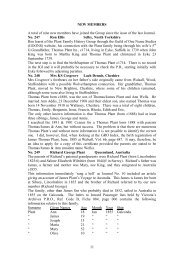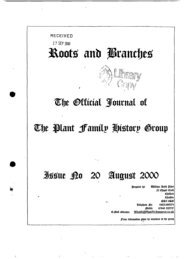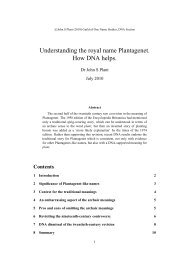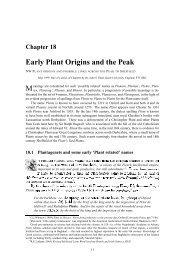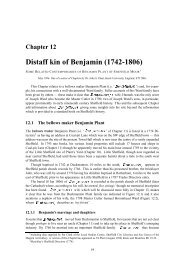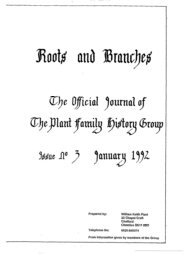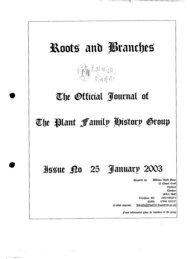Chapter 34 Austin Plant - Plant Family History Group
Chapter 34 Austin Plant - Plant Family History Group
Chapter 34 Austin Plant - Plant Family History Group
Create successful ePaper yourself
Turn your PDF publications into a flip-book with our unique Google optimized e-Paper software.
Mr Samuel Solly, Vice-President of the Royal College of Surgeons Fellow of the Royal Society, surgeon and<br />
lecturer on surgery at St Thomas’s Hospital, was then called and examined with regard to the ward in which<br />
the women died. He gave the same evidence with respect to having visited the wards at night on the 4 th inst.<br />
As that reported in The Times on Tuesday, and then he went on to say: - I recollect No. 24 ward, the female<br />
medical ward. As to paying attention to the state of the ward, I could not enter it without paying attention to<br />
its condition. It was frightfully foul, and I cannot use expressions strong enough to describe its condition<br />
beyond saying it was frightfully foul. I attribute its foul condition to the human exhalations arising from<br />
crowding a great number of people into a small space. The ventilation of this ward and of No. 11 came, I<br />
observed, through the water-closets and the bad smell came, no doubt, in part from the water-closets, so the<br />
stench in the ward was a mixed one. I think such a condition of atmosphere would act upon the inmates so as<br />
to produce a serious apoplexy wherever there was a tendency to it. The blood of the patient would be arrested<br />
in its flow by the condition of the atmosphere, and the result would be an effusion of serum. The postmortem<br />
in this case shows that there had been congestion of the ventricles, and I consider this was owing to<br />
the bad atmosphere of the infirmary. I do think the condition of the ward would hasten the death of a person<br />
labouring under bronchitis. Persons labouring under these diseases needed to have the purest air possible.<br />
With regard to the space question, I was unable to answer positively your question at the inquest on Monday,<br />
with respect to the exact space about to be given at St Tomas’s, and when asked I said about 1,800ft. I have<br />
since made inquiries, and I find that the space given will be 1,800 cubic feet, and in special cases, 2,000.<br />
In answer to the jury, the witness said that he considered it very improbable there would have been effusion<br />
of serum on the brain in the deceased had the necessary space for breathing fresh air, and he did not see one<br />
ward which was unobjectionable. All were bad, but several were extremely bad, and with the exception of<br />
one or two wards for special cases the wards were overcrowded.<br />
A general conversation ensued, in which it was proposed to go and visit the wards. To this a majority of the<br />
jury objected that they were not technically educated so as to judge of the wards, and they would rather trust<br />
to the knowledge conveyed to them by the medical gentlemen that to their own views. Several of the<br />
guardians desired to escort the jurymen round the wards, and seemed somewhat disappointed at this view.<br />
The Coroner proceeded with the case when order had been restored, and the jury returned a verdict – the<br />
Coroner saying it was clear that death had arisen from the overcrowding – that deceased came by her death<br />
“from the mortal effects of an effusion of serum on the brain,” and that the death was “accelerated by<br />
overcrowding and the want of ventilation in the St Pancras Infirmary.”<br />
A juror said something ought to be said in the verdict about the guardians not having taken notice of Dr<br />
Ellis’s report of six weeks since with respect to the want of ventilation.<br />
The Coroner replied that to do that other evidence must be called, and he deprecated such action.<br />
The inquiry into the death of Julia Cowden, aged 30, then opened. This deceased had been in the workhouse<br />
before, and came in a second time 14 days before. She was put into No. 24 ward, in which were 27 beds, and<br />
two on the floor, making 29 patients. Deceased died on Sunday morning. The nurse further said the deceased<br />
had been a hardworking woman. The ward was very close, and the patients complained very much. There<br />
was no artificial means of ventilation of the ward. The evil of overcrowding had been increasing during the<br />
14 months she had been employed in the building.<br />
Dr Ellis, the medical officer gave evidence regarding this death similar to that already given. The post<br />
mortem gave the same indications of congestion of the brain, and the fullness of the ventricles, as in the other<br />
case, and the death arose from the phthisis, accelerated by the bad atmosphere. Dr Ellis said that he had<br />
constantly reported to the guardians of the overcrowded state of the infirmary during two of the five months<br />
he had held the appointment. It was well known that the same thing occurred last winter, but it had come<br />
with increasing force this winter.<br />
The Coroner said Mr Carter, who accompanied Mr Solly, could give the jury independent evidence with<br />
respect to these wards at night.<br />
Mr Robert Brudenell Carter, FRCS, of 8 Princess-street, Hanover-square, stated in answer to questions put by<br />
the Coroner, -“I have been surgeon to great military hospitals in the East, surgeon the ophthalmic hospitals,<br />
and surgeon to the Nottingham Workhouse, I am, therefore, quite familiar with the management of hospitals<br />
and workhouse wards. I accompanied Mr Solly in his visit to these wards and I went into No. 24 ward as well<br />
52



